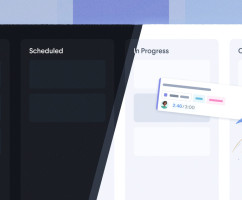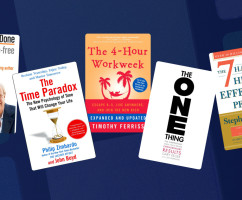"Eat That Frog" is a short book by productivity expert, Brian Tracy. It’s also a time management strategy (or set of strategies, rather) that will help you get more done faster.
In this article, we’ll review what "eating that frog" actually means, as well as briefly summarize the 21 things you can do to overcome procrastination and manage your time effectively.
As with most of the time management strategies and techniques we discuss, you can adopt this strategy at work as an individual or a team, or at home in your personal life. The applications are endless!
What Does Eat That Frog Actually Mean?
In this case, a frog is simply a metaphor for a task. But, not just any task. The biggest, most important task. The one you are most likely to procrastinate instead of doing. "Eating" that frog simply means doing the task.
With this in mind, what do you do if you have more than one frog to eat? After all, most of us do. Well, you eat the ugliest first!
If you need some help deciding which task is uglier, consider using a prioritization strategy—the Ivy Lee Method, or the Eisenhower Decision Matrix—though there are a slew of others to choose from.
Once you know which frog you’re going to eat first, you’re ready to move on to mastering the 21 steps Brian Tracy lays out in his book.
21 Tactics That Will Help You Eat That Frog
Given Brian Tracy has an entire book dedicated to these 21 principles, we’re only going to review them broadly. You’ll have to buy the book if you want an in-depth guide. This should, however, be enough to enable you to get started and Eat That Frog!
1. Set the Table
Before you do anything, it’s important to decide on what you want to achieve in each area of your life. If you decide what you want early on, you can approach task prioritization in a more targeted manner. Think of this like you would "goal setting." You’ll also find it easier to do hard work and to focus if you keep in mind what it’s all for. So, before anything else, write your goals out so they’re real, then start making progress against them, ideally, every single day.
2. Plan Every Day in Advance
Some time management strategies will prompt you to do this the evening before, or the morning of. Whichever you choose, the key is to plan out your day in advance of starting on it. This will make it easier to take action, and keep you on target. Take the extra step and plan your week and month in advance, too. Use lists to keep track of tasks and to get ideas out of your head.
3. Apply the 80/20 Rule to Everything
The 80/20 Rule—Also known as Pareto’s Principle— states that 20% of your tasks/activities will bring you 80% of the results/awards. Figure out what those tasks are and focus your energy! Spend more time working in these few areas that have a big impact on your work or life and you’ll find yourself spending much less time on activities and tasks that don’t contribute as much value.
4. Consider the Consequences
What tasks will have the biggest impact on your life? On your work? On the outcome? By considering the consequences of doing or not doing something, you should be able to more easily focus on the things that will have the biggest impact.
5. Practice Creative Procrastination
Procrastination doesn’t have to be avoided at all costs. If you can procrastinate productively, for example, by getting a whole bunch of smaller tasks you’ve been avoiding, completed, at least then you’ll be making headway. After all, a lot of our small yet ugly frogs still need to be eaten.
6. Use the ABCDE Method Continually
Prioritization strategies like the ABCDE Method can help you figure out which task to complete first. Naturally, you could also use the Ivy Lee Method, the Eisenhower Decision Matrix, or any number of other prioritization strategies. The point is to use one and to use it regularly!
To prioritize your tasks using the ABCDE Method, start by listing them all out. "A" items are most important, "B" items only have minor consequences, "C" tasks have no consequences, "D" tasks can be delegated, and "E" tasks can be eliminated. The ticket to this system is to spend your time on the activities that add the most value.
7. Focus on Key Result Areas
If there are areas of work, or specific tasks that will yield good results, you will want to focus on those areas. Try to identify where you have the biggest impact, and do those things that will generate results.
8. Apply the Law of Three
Limit yourself to only doing a few of the most important things as they will account for 90% of the results. Brian Tracy suggests limiting this to three tasks. To identify these tasks, ask yourself which task would provide the greatest value if you had to do it all day. That’s the one you should start with. Do this twice more to get your list of three.
9. Prepare Thoroughly Before You Begin
Before you begin working on anything, the best way to prepare yourself is to have everything you need. Make sure your workspace is clean and distraction-free and that your working environment is positive and conducive to productivity. Clear the clutter! You should find that the next time you sit down it will be that much easier to be efficient and get right to work.
10. Take It One Oil Barrel at a Time
Not all tasks (or frogs) are equal. Some are a lot larger than others. To eat your frog, take it one bite at a time. Take that one big task you need to complete and break it into a list of smaller steps. Then, take that first step immediately. It may be all you need to get started. Once you’re done with the first step, move on to the next one. Keep taking it one at a time.
11. Upgrade Your Key Skills
In order to work to the highest level you are capable of, it’s important to identify your key skills, and then to update them. This will make you better at eating your frogs, and make getting high-quality work done easier and faster. According to Brian Tracy, a key reason most of us procrastinate overdoing something is a feeling of inadequacy or confidence in doing the task. In order to discourage such feelings, keep learning!
12. Identify Your Key Constraints
As with identifying your core competencies, it’s also important to identify the things holding you back. What is stopping you from achieving your goal? What is slowing you down? You really have to look internally here. Be honest with yourself and keep asking questions. A constraint, for example, might be an ability you don’t have, or a habit you’ve got, or a discipline you adhere to/don’t adhere to. You may find that the very frog you need to eat is something related to that constraint.
13. Put the Pressure on Yourself
Don’t wait for someone else to motivate you, or to tell you what to do. Put that pressure on yourself! Be the driver. You have to if you want to reach your full potential. Brian Tracy suggests giving yourself a role model, or setting standards for yourself that are higher than others' standards for you. He also suggests creating imaginary deadlines for yourself, if you don’t already have them. This is also a great time to use a time tracker like HourStack. Beyond setting deadlines for yourself, you could set the clock. If you say you’ll get something done in two hours. Try to get it done in less time. Put that pressure on, if just to show yourself you can do it. You’ll be surprised to find you’ll even start improving your self-esteem.
14. Motivate Yourself into Action
Your internal dialogue is actually what creates your emotions. Try to develop a positive internal dialogue. Be your own cheerleader. If you start to find yourself allowing negative thoughts to overwhelm the positive, try to change your self-talk. You will also find it easier to stay positive if you refuse to criticize or blame others, make progress instead of excuses, and keep your energy focused on moving forwards!
15. Technology Is a Terrible Master
Technology can be a huge distraction in our daily lives. Not only does it make it harder to get into the flow if you’re always being interrupted, or worrying about being interrupted, but it wastes time, and prompts reactive actions rather than proactive actions. Try to limit your time using technology. At the very least, save an hour each day for detoxing, and a day each week for the same. In time, you’ll feel calmer and be able to think more clearly. You’ll also get space to recharge!
16. Technology Is a Wonderful Servant
Just as technology can be a terrible master, it can also be a wonderful tool. To wield this tool to your advantage, you need to have discipline. A great way to use technology is to have it remind you of the things that are most important in your life and to use it to protect you from the things that are least important. Some tools really do help with this. For example, using a tool like HourStack, you can block chunks of time to get work done, and then hold yourself accountable by starting the timer. Digital to-do lists also make it easy to delegate faster. At work, you could also give people specific times to contact you or not contact you.
17. Focus Your Attention
Unsurprisingly, the key to high performance is attention. Multitasking and distractions lower attention span and thus result in more errors and poorer performance on the job. While multitasking may make you feel more productive (or busier), task shifting has a big impact as attention residue from the previous task will take up mental space, giving you a much worse ability to focus wholly on the task at hand. So, if you can turn off notifications that distract you, don’t check your email first thing in the morning and leave your devices on silent. If you’re working on something, be wholly present. Don’t sit on your phone or your laptop as you do it.
18. Slice and Dice the Task
A primary reason we often procrastinate on doing our most important tasks is that when you first approach them, they may seem large and insurmountable. One way to deal with this is to take that task one slice at a time. First, outline the task in detail, as a whole. Write out the steps in the order that they appear. Then, just tackle one slice of the pie. Once you’ve done this you may feel like tackling another slice, but if you don’t, that’s okay, you got started. Keep tackling your big task in this way and before you know it, you’ll be done.
19. Create Large Chunks of Time
One of the main reasons time blocking works so well is that it allows you to block off chunks of time to get work done. This can help you focus, can reduce distractions, and can simply give you the space to chip away at your work. If you use HourStack, this time management strategy works like a charm.
20. Develop a Sense of Urgency
Even if you don’t have a deadline for a task, make one for yourself. The most successful people are action-oriented, meaning that they have a sense of urgency around getting their tasks completed. By doing the same thing for yourself, you’ll find it easier to enter into a “flow” state and as a result feel calmer, happier, and more accomplished. If you can develop a sense of urgency in everything you do, you’ll be surprised by just how much you can do! Try to take action on things quickly, and report back to people fast.
21. Single Handle Every Task
Many successful salespeople advise never to touch the same piece of paper twice, meaning that it’s best to deal with each task as it comes in, instead of dealing with it a little, setting it aside to do something else, and then returning to it to deal with it again. Similarly, if you can handle your tasks only once -- begin working on your task and keep doing so without distraction -- you’ll find you can perform at a higher level and be more personally productive. Imagine how much time is wasted by continually returning to the same task. You probably have to refresh yourself on the details each time you do.
How to Eat That Frog With HourStack
Many of these techniques can be easily used in conjunction with HourStack. For example:
- Use HourStack to time block your schedule so that you can carve out chunks of time to focus on specific tasks.
- Use time tracking to monitor how long you take to accomplish certain tasks (try to beat your own estimations and records).
- Use labels to prioritize tasks, or drag-and-drop them to change their order in day view, week view, or month view.
Make Your Ugly Frogs Stand Out
One thing we like to do if we’re using the Eat That Frog method is to take advantage of the frog emoji! 🐸 Label your frog each day so it’s clear which task is the most important. If you can, limit yourself to three tasks (ugly frogs) a day.
Combine Different Strategies and Techniques
The screenshot below illustrates a combination of prioritization strategies. The frog emoji points out which task is the ugly frog, and the labels illustrate what the calendar owner intends to do with the tasks using the ABCDE Method (also by Brian Tracy). If you recall, "A" items are important, "B" items are of less importance, "C" have no consequence, "D" items can be delegated, and "E" items can be eliminated.
While this example doesn't limit the day to three tasks just yet, a couple of the additional tasks are relatively small and so, shouldn't take up a lot of time, or can be delegated or eliminated.
Eat That Frog With Your Team
To use Eat That Frog with your team, encourage them to read this article. It will encourage them to become familiar with the 21 techniques that will help them overcome procrastination and get work done.
It will also prompt you to think more carefully about which tasks you assign are ugly frogs. Consider each team member’s strengths and weaknesses, and consider asking everyone to do their own analysis of personal strengths and weaknesses.
Updated September 21, 2022 in Tips & Tricks






